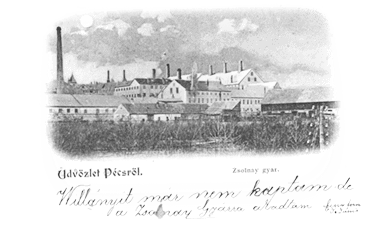The period of the foundationof of the manufacture
In 1853 production began the in the Zsolnay manufactory, and Miklós Zsolnay had the factory with an operating permit registered on his son’s Ignác Zsolnay’s name on 25 April 1853. at.
Ignatius enthusiastically led the small factory for years, but due to financial difficulties, his younger brother, Vilmos Zsolnay, a merchant (1828-1900) backed him with loans, then entered into the business as a silent partner in order to support his brother, but a year later, Ignác left the country, thus the company was left to Vilmos.
In 1865, Vilmos Zsolnay (1828-1900) at the age of thirty-five, took over the management of the small plant without qualifications and skills. Earlier he had studied in Vienna, then worked in German cities as an assistant merchant. In his youth he cherished artistic ambitions; he skillfully painted and drew, but his parents persuaded him to become a merchant.
His mother, Teréz Ballay was Vilmos Zsolnay`s greatest accomplice and help of whom he could always count on. They were at exceptionally good terms; his mother was a supporter and confidant of Vilmos.
Vilmos had no expertise, therefore, in the initial period he had to rely on the help of others: in the streets around the factory, in the nearby streets of today Felsővámház, Major, Felső-and Alsóbalokány, and in some of the present buildings of Street of Shops he had some houses built for the workers mainly coming from abroad. Vilmos Zsolnay soon realized that the key of succes for the small manufacture lies in continuous large-scale development. All of his business decisions were meant to help the development of the plant. He needed financial and intellectual capital. He educated himself, because ceramics industry was unfamiliar territory for him.
The Development of Zsolnay Factory
Vilmos Zsolnay quickly recognized the demands of the market, and he won positions by his innovative solutions and his own inventions in all areas of ceramics industry. Simple pottery did not satisfy him; he was longing for something more since the beginning. At first he mixed the local materials from those of coming from other areas, trying to find the recipe for making everything, he wanted to prepare the necessary materials himself. He completed his calculations, and was taking notes in his study in the attic.
The plant initially employed 20-25 people by 1871, including foreign-speaking - mainly German - technically directors. Zsolnay learned a lot from them, but the collaborative trials mostly ended up in disappointment. Vilmos recognized that results can be achieved by ongoing research and development and by providing high quality, therefor his objective was to produce especially fine, high quality decorative objects.
In 1868 the factory had only two departments, the refractory stone and tile factory, and the latter manufactured china, too. In 1895 the stone tile division split into two parts: the earthenware (faience) and Porcelain departments. In 1885, the pipe factory was founded, while in 1886 the stove factory and in 1895 the pyrogranite factory was established.
In order to provide skilled labor force Vilmos Zsolnay set up a school in the area of the factory whose students were mostly sons of the workers. The workers often worked in the Zsolnay factory for generations.
By the turn of the century, Vilmos Zsolnay developed the small manufactory initially employing only a couple of workers into the largest ceramic plant of the Austro-Hungarian Monarchy, where nearly seven hundred people worked. The hard work of Vilmos Zsolnay played a major role in the success.
Important milestones:
The Vienna World Expo brought success in 1873. The professional jury was enchanted by the product range of the potter from Pécs, which was rewarded with a grand bronze medal and diploma recognition, while the king rewarded him with a Ferencz Jozsef order of merit. The international markets opened for Zsolnay, and experience gained atthe Vienna World`s Fair made Vilmos begin experimenting with high-temperature glazes.
From this point, there was no way back. The glae and mass experiments of the ever-busy Vilmos Zsolnay working continuously in the lab, resulted in his first invention of pottery, the porcelain faience technique which was used for making both everyday household as well as for ornaments. Glaze is such a decorated earthenware object whose absorbency of water is of 5-10%. Porcelain is a 0.5% absorbent material decorated by paint. The peculiarity of Vilmos Zsolnay’s porcelain faience invention laid in the fact that the object made by the known porcelain technique was decorated by glaze (ie, by glaze, instead of porcelain paint). The subject material and the glaze colors were developed into one by the so-called Scharffeuer - the very high temperatures of – burning.
At the 1878 Paris Exposition Zsolnay already exhibited these products. The expert jury did not believe his eyes: they doubted that the objects were made without borax and lead. Miklós Zsolnay (Vilmos Zsolnay`s son) threw an exhibited objects to the ground with youthful vigor to deliver some fragments to the skeptical Committee for chemical analysis. It was only after thorough chemical testsm when the jury accepted that the glaze used by the Zsolnay factory was unleaded. The recognition did not fail to come: Vilmos Zsolnay was rewarded with a gold medal and the National Order of the Legion of Honour.
The development paved the way for the improvement of artistic standard of his products and the elaboration of a unique style. This sytle, in addition to the Hungarian motifs mainly reflected the impact of the Persian and Iznik (Turkish) ceramics, and was based on the design work of Júlia (Vilmos Zsolnay`s daughter).
At the time of the birth of porcelain faience technique, in 1877, Julia Zsolnay designed the trademark, which served the promotion of the factory for decades. Besides the five towers, which referred to the German name of Pécs (Fünfkirchen) the three letters came from the initials of the names of the three siblings (Teréz, Júlia and Miklós).
"I have never been encouraged by either lucre or ambition. You know that I am not longing for money or anything else. Some internal drive stimulates me for work and creation, it has always meant life to me." (wrote Vilmos Zsolnay in a letter to his brother Ignác)
Pyrogranite and eosin technique
Pyrogranite was invented by Vilmos Zsolnay. I was came into existence through the continuous development of architectural ceramic materials, and was created specifically to substitute for the costly stone carvings on the facades of historical buildings. It is architectural ceramics fired at high temperatures with a grainy structure resembling to sandstone. Pyrogranite is well suited for both external and interior applications either unglazed or with various glazes (majolika-, eozin-, salt glaze). The Pyrogranite plant within the Zsolnay factory was established in 1895.
Eosin is based on the reduced-pasty luster technique already in use by the Persians in the 7th century. So in fact, it I not a new inventions, but the further development of an old, traditional procedure of which Vilmos Zsolnay developed an array of unique varieties.
Chapters 1-18 of the fifth book of recipes of Vilmos Zsolnay started in December 1891 includes the recipes of Professor Vince Wartha, chemist, and professor at the University of Technology, while chapters 18-53 included his own experimental results.
Besides the working relationship of Vilmos Zsolnay and Vince Wartha, the two men was linked together by mutual recognition and friendship. Eosin technique was presented at the 1896 National Millennium Exhibition as their joint invention.
Family and social life
Vilmos was a really sociable person, he enjoyed spending time with his family and the friends of his children. They often arranged small gatherings, as he was absolutely fond of humor, meaningful conversations and heated discussions. Over time, the company was expanded with the members of the creative team who worked in the Zsolnay Factory for a while.
A large colony of artists worked here, and their hostess was Teréz Zsolnay. The "new-comers" of the family soon began working in the factory. This happened to Jakab Mattyasovszky geologist who met Teréz in 1880 at a carnival ball, and after they marriage he helped in the factory in finding and analyzing the right materials. Teréz`s sister, Júlia Zsolnay became an acknowledged painter in her own right. In 1883, she married Tádé Sikorski, an architect of Polish descent, who had spent a year-long field trip at the Pécs factory, but later became the designer and art director of the factory. Many decorative ceramics are the result of the joint work of the couple: Júlia Zsolnay designed the décor, while Tádé Sikorski developed the shape.
The whole family lived and worked here from 1880. The daughters (Teréz and Júlia) took part in the planning, while Miklós helped his father work and was responsible for the management of their trade relations. Vilmos Zsolnay called by contemporaries "the greatest Hungarian potter” made just a few objects with his own hands, but his intuition, imagination desires, practicality, versatility, striking personality helped him multiply the power of his own: his dedication and faith infected everyone.
The residential houses and the garden
The family lived in buildings situated in the area of the factory. Vilmos experimented with new methods, techniques, and materials in the basement of the building of today`s Family and Factory History Exhibition. On the ground floor and first floor there were apartments.
Vilmos Zsolnay was enthusiastic and knowledgeable gardener who achieved particular success in growing melons, but he was also known for his roses. In 1860-70-ies, he had commercial orchard operated by a German horticulture specialist. In the 1880s grapes were grown, and a vegetable garden was maintained yielding artichokes and asparagus. The slopes under the "Green House" (today Bóbita puppet theatre) were covered by rose bushes. Between the two world wars, a small artificial lake was established, where water lilies were planted. Vilmos Zsolnay established a greenhouse, which even after decades of nationalization provided perennial plants for the garden.
The late 19th century
The work of Zsolnay factory rose to its climax in the last years of the 19th century, in the art nouveau period. Operating 9 giant and 15 smaller furnaces, the factory employed more than 700 workers. Not only former village potters worked ehre, but Czech, German, Moravian as professionals as well, including their children, who were apprentices here.
The Zsolnay works of art participated in many international exhibitions and won several awards. This period saw their own commercial agencies, market relations, solid professional and social esteem, however, this is already related to the person of Miklós.
Miklós Zsolnay, as the head of the factory
After Vilmos Zsolnay had passed away in 1900, his son, Miklós Zsolnay came to lead the, who, as a manager, primarily focused on doing business. He was a good-looking, highly educated, multilingual, pleasant social person who had excellent relationships. He shared his incredible energy between the company`s management and a number of other activities. Very significant business deals and investments are attached to his name, not to mention the golden age of Zsolnay, which, in part, was due to the achievements of the descendant of good business acumen and skills. The organization of the National Exhibition in 1907 is regarded as the peak of his success.
At the 1900 World Exhibition in Paris the new collection of the Zsolnay factory was presented. The new works did not intend to serve but to reshape the public`s needs. A multicolored painted Zsolnay Art Nouveau decorative pots made with different technique met unanimous accolades. Art Nouveau breaks away of historical past and aims at creating new forms truly expressing the new momentum of modern life using stylized motifs of the flora for its free-flowing forms.
Miklós spent much of his considerable income for public purposes. Under the guidance of focus has been shifted to the production of architectural ceramics and insulating. Although it was him who invited the young artists of applied art to help the adoption of the Art Nouveau style in the context preparation for the 1900 Paris World Expo, he soberly assessed the decrease in demand for ornamental items.
Under the guidance of Miklós Zsolnay, the Zsolnay factory in Pécs and Budapest won leading position in all areas of ceramic industry except for porcelain production within the Austro-Hungarian Empire. They manufactured stove tiles, ceramic and refractory bricks, tiles, architectural ceramics, vitrified clay sewer pipe, porcelain insulators, household utensils, sanitary goods and of course the eosin porcelain and faience decorative pots of artistic value, which presented the brand name.
Miklós Zsolnay managed to reach all his important goals: by the acquisition of his competitors he gained market leader position, and by providing the unds needed to develop from his own sources, he ensured that the company remained in the possession of the family.
This also meant that everyone had their own mission, family members subordinated their personal lives to common goals.
The generation of the grandchildren began working under the direction of Miklós. Of the grandchildren of Vilmos Zsolnay it was Mattyasovszky Tibor who started working in the Zsolnay factory first in 1905. In 1907 Zsolt Mattyasovszky Zsolnay began his career as a chemist. Following th ewishes of his father, Miklós Sikorski Zsolnay earned a degree in architecture and worked in the pyrogranite plant.
Mausoleum
The Zsolnay Mausoleum was erected by Miklos following the death of factory founding Vilmos Zsolnay in 1900, on the hill immediately adjacent to the factory, according to the design of Vilmos Zsolnay’s son in-law, architect Thaddeus Sikorski. The development of the construction and the environment began in 1901. All factory workers were involved in the construction of the building lasting until 1913, creating everything themselves including the smallest details. It is a worthy tribute to the spirit of the great master potter and a great summary of the vision and accomplishments of the Zsolnay factory.
Hardships after the First World War
November 14, 1918, Serbian troops invaded the southern part of the County including the city of Pécs. Miklós Zsolnay fearing that the Serbian army will take him hostage, went to Budapest and died there in 1922. Then, three nephews, Tibor Mattyasovszky Zsolnay, Zsolt Mattyasovszky Zsolnay, and Miklos Sikorski Zsolnay jointly managed the company. However, the new management faced serious difficulties. Due to the post-World War I Treaty of Trianon, and the disintegration of the Austro-Hungarian Empire, they lost a large part of the market and their sources of raw materials. Zsolnay factory was struggling with the narrowing of the market and the scarcity of raw materials as it faced a currency devaluation as well. Whatever they gained, it had to be given to investments to ensure the survival of the factory so that the heirs could not get to their share of the heritage.
The period between the two world wars
After the First World War, in the years following the disintegration of the Austro-Hungarian Monarchy demand for both ornamental items and pyrogranite diminished.
The machinery become obsolete and a wide range of products was untenable, therefore the grandchildren’s generation began the transformation of the factory. It was obvious that in addition to the required improvements in insulation manufacturing they needed to deal with porcelain production as well.
In 1925, the factory reached the brink of bankruptcy. They had to introduce a four-day working week and the company was forced to lay off two hundred workers, so no wonder that the production of ornamental products was temporarily came to a halt. The manufacture of artistic porcelain sculptures began in 1926.
Socialization
In the morning of Good Friday in 1948, citing ministerial instructions, Tibor Mattyasovszky Zsolnay was called upon to leave the factory. Members of the Communist Party had been conducting propaganda in the Zsolnay factory, too, since 1945. Family members, some of whom still lived in the factory, were still unprepared for the measure. They could take neither the bulk of personal belongings nor their art collection in the factory with themselves. Hard years come for the members of the Zsolnay family. In the period following the socialization, the new leaders of Zsolnay factory methodically sought to eliminate the "bourgeois" tradition, whereby they mainly meant the focus on the production of decorative items. However, after many challenges and hardships, the famous factory is still operating, and the open-vew manufactory allows an insight into the work going on there.








































